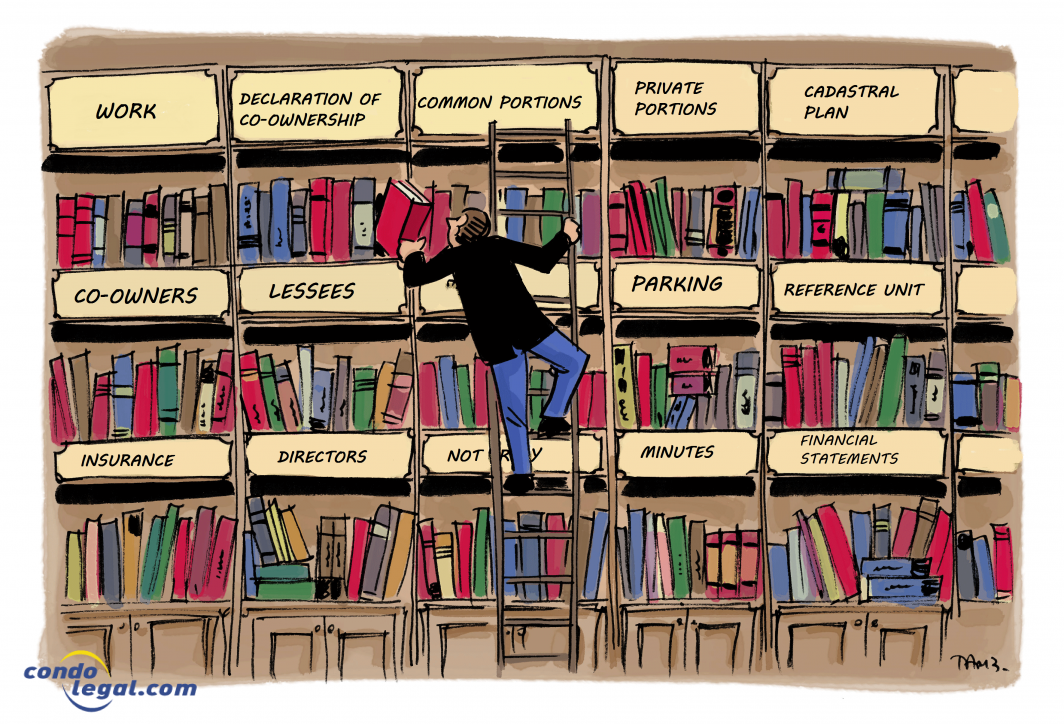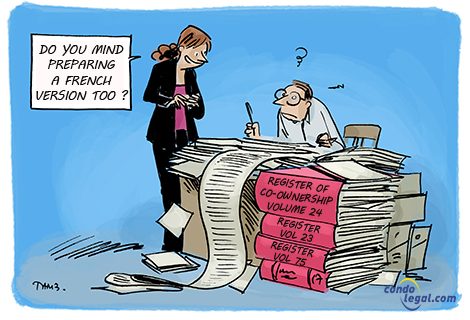 When you want to buy a condo, there are important checks to do and documents to obtain. One of the main checks is to know the financial health of the syndicate. This information must be complete and transparent. If the co-ownership has been poorly managed, you could find yourself paying significant special contributions that could put you in a precarious situation. That is why we need to collect as much information as possible. Thus, you will limit the financial risks associated with your acquisition. In principle, the syndicate's board of directors.should provide relevant documentation and information on this subject.
When you want to buy a condo, there are important checks to do and documents to obtain. One of the main checks is to know the financial health of the syndicate. This information must be complete and transparent. If the co-ownership has been poorly managed, you could find yourself paying significant special contributions that could put you in a precarious situation. That is why we need to collect as much information as possible. Thus, you will limit the financial risks associated with your acquisition. In principle, the syndicate's board of directors.should provide relevant documentation and information on this subject.
Access to documents or information concerning the immovable and the syndicate
Article 1068.2, introduced into the Civil Code of Quebec by Bill 16, requires the syndicate to give the promising buyer the documents or information enabling him to make an informed choice. The legislator mentions that documents and information must be provided diligently to the promising buyer, at the latter's expense, subject to the provisions relating to privacy, for example articles 37 to 41 of the Civil Code of Quebec. These are, essentially, the documents or information concerning the immovable and the syndicate. Once these have been communicated to the promising buyer, the syndicate must inform the owner, so that all parties have identical information. To learn more about this, see this question/answer. It specifies how to access the documentation of a co-ownership.
Documents to obtain
Among the documents relating to the building and the syndicate to be claimed, several of them are essential:
Insurance policies of the immovable
The subscription by the syndicate of an insurance policy covering the immovable and its civil liability is compulsory under the Law and most declarations of co-ownership.This insurance must cover the common portions, the private portions (excluding the improvements carried therein), and the syndicate’s movable property. A factsheet on this subject has been prepared in the Insurance section.
Given the tightening of the Quebec co-ownership insurance market, a buyer must check the quality of the coverages that the syndicate has subscribed. And for good reason, since nowadays, the transactional stake related to insurance is enormous. You should know that the coverage offered is decreasing in number, while premiums are increasing considerably. As for franchises, they can reach tens or even more than a hundred thousand dollars. These staggering amounts can be imposed, in order to obtain certain coverages, for example those related to water damage. That said, in some cases, this type of loss is no longer covered.
Prohibitive premiums and deductibles may affect the cash flow of a syndicate of co-owners. To remedy this situation, the legislator has made the creation of a self-insurance fund compulsory. This fund must equal the highest deductible of a policy. If it amounts to $25,000 or more, the surprise could be colossal for a buyer. Moreover, a Factsheet is devoted to this subject in the Insurance section.
Appraisal report
An appraisal report of the immovable must be obtained by a competent firm and be up to date. Warning: if this report is three years old, or even more, the insurable value of the building may be exceeded, so that the syndicate concerned would find itself underinsured. In the event of a claim, it would be subject to the proportional rule. This would result in the compensation obtained possibly being less than what it would cost to repair the damage. Remember that the reconstruction cost is established by a chartered appraiser. It must consider, in particular, the costs related to demolition and professional fees, such as those of an engineer or architect, retrofitting to standards, use and the rules of the trade, as well as applicable taxes (GST and QST). In short, the syndicate's insurance coverage must not only reflect the actual value of the building, but also include all related costs.
Reference unit
The reference unit is a technical sheet, the purpose of which is to describe the original facilities in your unit. It must be sufficiently detailed, to identify the improvements the co-owners may have carried out therein. You will be able to assess, if necessary, the value of the improvements and take out insurance to cover them. Failure by the syndicate to establish one or more reference units is likely to have serious consequences. What for? Because this can lead to situations of insurance insufficiency, since components that were formerly insured by co-owners fall, therefore, into the lap of the syndicate's insurance. It can also create inequities for some co-owners, by making some pay for the insurance for each other's improvements.
Minutes of the meetings of co-owners and the board of directors
It is essential, for the prospective purchaser, to consult the latest minutes of the meetings of co-owners and the board of directors. These documents will reveal the state of mind that reigns in the building. Thus, you will know in what climate these meetings take place. Are these meetings serene and harmonious or stressful and tense, degenerating in open conflicts or, in some cases, litigation? To find out what is going on, you should at least read the minutes of the last three years. Also, these minutes will give you a general overview of the work carried out in the immovable and what is foreseeable.
Maintenance logbook and Contingency fund study
Prepared by a building professional, the maintenance logbook lists all the technical information about the maintenance methods recommended in the common portions. It also indicates the work that has been carried out in the building, draws up an inventory of its components (usually the common portions). This booklet also provides a maintenance schedule indicating the maintenance or replacement operations carried out or to come.
In addition, board members should have a contingency fund study prepared. In fact, under Bill 16, these two management tools will eventually become mandatory. The buyer therefore has an interest in checking if they are already in place in the coveted co-ownership. It should be noted that even if this obligation has not yet come into force, syndicates that do not have one should be proactive in obtaining them now.
Information to obtain
In the case of resales of residential co-ownerships, buyers sometimes have difficulty obtaining from the syndicate the information required to make an informed decision. This is why article 1068.2 of the Civil Code of Quebec obliges the syndicate to give the promising buyer the relevant information. Among the essential information to obtain, that relating to the contingency fund is one of the most important. It is known that the sums allocated annually to this fund are often insufficient to cover the cost of major work that only a contingency fund study can establish accurately.
Contingency fund statement
Like a car, the building will, sooner or later, be in need of major repairs. You must review these expenses carefully, and more particularly, work related to the roof, the elevators, the windows or any other major components of the building. All this work should be funded from the contingency fund. The money deposited therein, with the interest, shall be used only to pay for the two following expenditures: major repairs and the replacement of common portions at the end of their normal life expectancy.
Thus, the contingency fund should be sufficient; otherwise you will be called to finance it (in part) out of your own funds. An insufficient contingency fund will lead, without fail, to a call for a special assessment from the co-owners. Therefore, you should evaluate the sufficiency of the contingency fund of a co-ownership, in order to negotiate in full knowledge the purchase price of the coveted apartment.
 WHAT YOU SHOULD KNOW! The review of the balance of the contingency fund, by consulting the financial statements of the co-ownership, allows the purchaser to make a preliminary evaluation of its sufficiency. The amounts accumulated therein (over time), are not subject to any limit. They usually are established on a variable basis, in accordance with the information in the Certificate of the state of the immovable.
WHAT YOU SHOULD KNOW! The review of the balance of the contingency fund, by consulting the financial statements of the co-ownership, allows the purchaser to make a preliminary evaluation of its sufficiency. The amounts accumulated therein (over time), are not subject to any limit. They usually are established on a variable basis, in accordance with the information in the Certificate of the state of the immovable.
 WHAT TO KEEP IN MIND: The decisions taken by the board of directors and the meeting of the co-owners must be recorded in minutes. This document is essential for a co-ownership, because it ensures the written preservation of the deliberations of these two decision-making bodies of the co-ownership, as well as that of the result of each of the votes, so that any co-owner and director can refer to them over time.
WHAT TO KEEP IN MIND: The decisions taken by the board of directors and the meeting of the co-owners must be recorded in minutes. This document is essential for a co-ownership, because it ensures the written preservation of the deliberations of these two decision-making bodies of the co-ownership, as well as that of the result of each of the votes, so that any co-owner and director can refer to them over time.
 WARNING! Too many syndicates stubbornly refuse to assess sufficient contributions to the contingency fund. Therefore, it may be so deficient that it causes the property to end up in a financial quagmire, more particularly when major work becomes unavoidable. In cases where the cost of the work exceeds the financial capacity of some co-owners, the building is at risk of suffering from a lack of maintenance. In the worst case scenario, the solvent co-owners will have, eventually, to pay in the place instead of those who are not able to do so.
WARNING! Too many syndicates stubbornly refuse to assess sufficient contributions to the contingency fund. Therefore, it may be so deficient that it causes the property to end up in a financial quagmire, more particularly when major work becomes unavoidable. In cases where the cost of the work exceeds the financial capacity of some co-owners, the building is at risk of suffering from a lack of maintenance. In the worst case scenario, the solvent co-owners will have, eventually, to pay in the place instead of those who are not able to do so.
Return to the super file Condominium Shopping Guide





